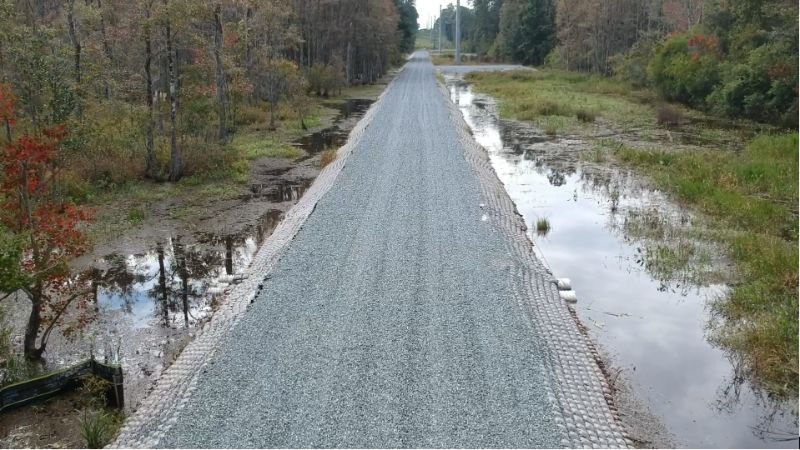Need help selecting the right FLEXAMAT? Use our Product Recommender.

Wetland Utility Line Access Road
A utility line can include any pipe or pipeline used for the transportation of any gaseous, liquid, liquescent, or slurry substance, for any purpose, and any cable, line, or wire for the transmission for any purpose of electrical energy, telephone or telegraph messages, or radio or television communication. Utility corridors often cross multiple wetland areas that are regulated by the State environmental agencies. However, these utility activities are often exempted from requiring a permit under the Wetlands Protection law. These include certain activities associated with the installation, maintenance or repair of utility lines and associated structures if they are done in a manner that minimizes any adverse effect on wetland.
On this project, the utility was a transmission line that passed through a state protected wetland. In order to build and maintain the transmission line, a 16' wide access road was constructed. The side slopes of the access road were a 2:1 slope and susceptible to erosion from the surrounding wetland, especially after tropical storm events. After tropical storms was when it was likely this transmission line would need to be repaired. It was critical that the access road side slopes exposed to flood waters would be permanently armored to protect the integrity of the the access road after tropical storms. Due to the transmission line passing through a state protected wetlands, any products used had to be approved by the appropriate environmentally agencies.
Both public and private utilities use vegetated concrete erosion mats to minimize environmental impacts. The utilities use the concrete erosion mats for permanent erosion control and for low water crossings. Utility corridors that intersect rivers, streams and wetlands require permanent erosion control. Tied concrete block mats allow native vegetation growth through the matting, creating a green-hard armor. Flexamat is environmentally safe for wildlife, including snakes, aquatic life and hoofed animals. Utility corridors pass through many remote and difficult to access areas. Tied concrete mats are shipped in compact rolls. This helps enable efficient transportation of materials to the remote sites as well as moving the materials onsite. One truckload of Flexamat® (4800 square feet), replaces 32 dump trucks of 18" rock rip rap. Using tied concrete block mats offers a transportation savings and significantly reduces the carbon footprint of the project.
The engineers with the private utility specified Flexamat® Standard for the side slopes of the access road. The project required 60 rolls of 12' x 50' Flexamat® Standard concrete mats. Even with the difficult access and narrow working conditions, all 36,000 square feet of concrete erosion mats were installed in three days on the 2:1 side slopes of the access road.
Within a month of project completion, Tropical Storm Cristobal made landfall in the Gulf Coast. The tropical depression promptly emerged in the Gulf on Day 1 of the official 2020 hurricane season. Weather stations recorded 8.98 inches of rain. This immediately tested the performance of the access road. The concrete erosion mats performed as design, supporting the integrity of the access road during the disaster repairs to the transmission lines. Following the initial Tropical Storm Cristobal, Hurricane Sally, Hurricane Delta, and Hurricane Zeta all brought heavy rain and flood waters to this wetland access road in it's first year of usage. Below is footage taken after flooding from Hurricane Sally.







